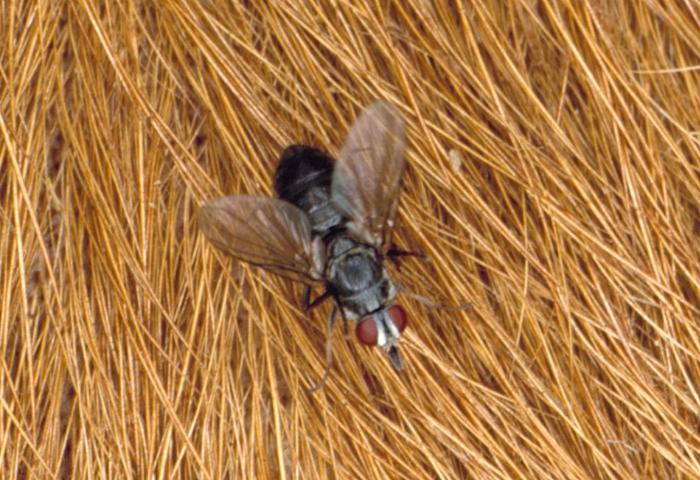
A cloud of horn flies (the numerous white specks), Haematobia irritans irritans (Linnaeus), feeding on cows. Photo credit: Lane Foil, Louisiana State University. Source: Horn Fly Haematobia irritans irritans
Dr. Lew Strickland, Extension Veterinarian,Department of Animal Science,University of Tennessee
Now that warm weather has arrived, everyone will start to focus on all the chores that have to be done to “gear” up for the upcoming season, including fly control. Fly infestation reduces performance and the economic loss from each horn fly biting an animal 30 times/day can also be substantial.
Certain flies are responsible for spreading diseases such as pink eye and potentially Anaplasmosis and or Bovine Leukosis, so to decrease disease risk to your livestock here are a few tips to reduce the flies’ impact on your farm’s production.
-

Horn fly. Photo credit: J. F. Butler, University of Florida. Source: External Parasites on Beef Cattle
Feed a larvicide or an insect growth regulator early in the season starting 30 days before flies typically emerge. Continue to feed until 30 days after a killing frost.
- Pour-ons. During spring turnout time, you can use a product that is labeled to control internal parasites, as these products also have efficacy against horn flies. Later in the year, use products only labeled for flies and/or lice. Using pour-on dewormers multiple times throughout the year could lead to internal parasite resistance issues.
- Dust bags/cattle rubs. The advantage of a dust bag or rub is that, if placed at a site where all cattle must use it (watering trough, mineral lick), it can provide economical control of face and horn flies. Proper placement and keeping it charged with insecticide are the keys. Also, strips that can be mounted to mineral feeders can also be an efficient way to apply insecticide to the face of cattle.
- Topical sprays. Timely application of fly sprays or paint ball style packets throughout the year can be effective in reducing the fly population, but can be time-consuming if cattle are grazing an extensive area.
- Fly tags. The key to using tags is to wait until you have 200 flies/cow to place the tags. If applied too early, there will be decreased efficiency. Use pyrethroid tags for two consecutive years, then switch to an organophosphate tag for one year to reduce pyrethroid resistance. Also, there are new generation fly tags that contain different insecticides and are quite helpful in controlling fly populations. Always follow label directions on the number of tags/cow. Be sure to remove tags at the end of the season to prevent resistance problems.
- Don’t mix classes of chemicals in the pour-ons, topicals, and fly tags within the same year. Use the same class 1-2 years, then rotate.
- Fly predators. Not all flies are bad. Fly predators, nature’s own self-inflicted enemy, can be your ally in the fight against pest flies. These are tiny, non-stinging, non-biting wasps that feed on fly larvae and interrupt the breeding cycle of flies, destroying the next generation of flies before they hatch into disease-carrying adults. These predators can be used in areas where cattle tend to congregate and manure tends to accumulate, just apply the predators to manure piles in these areas. Replenish your fly predator supply once a month from April to September; otherwise the fly life cycle will only be broken for a few weeks. (Source: Chris Carter, Southern States)
A multifaceted approach is best for attaining your goal of “controlling” flies, so using just one strategy from the above list probably won’t give you the results you anticipate. Since there are so many products on the market for fly control, work with your Extension Agent or veterinarian to develop a plan to control flies that best suits your cattle operation.
For more information on this subject, and control recommendations in Florida, use the following publication links:
Horn Fly Haematobia irritans irritans
Horn Fly Management
Latest posts by Doug Mayo (see all)
- May 2025 Weather Summary and Summer Outlook - June 20, 2025
- Friday Feature:The History of Angus Cattle - June 20, 2025
- Friday Feature:High Quality Legume Hay Production – Virtual Tour of Conrad Farms - June 6, 2025
